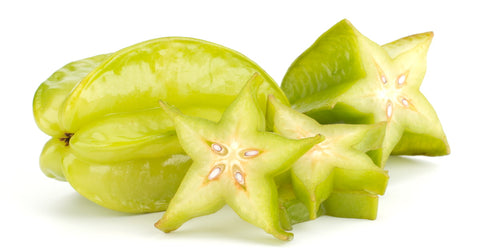Star fruit, with its distinctive star-shaped appearance and sweet, tangy flavor, is a tropical delight that has been gaining popularity worldwide. But beyond its visual appeal, star fruit, also known as carambola, offers a wealth of potential health benefits.
This article explores the nutritional value of star fruit, its potential advantages for various aspects of health, and how to safely incorporate it into your diet. We'll also discuss the importance of identifying food intolerances and how our food sensitivity test kit can help you make informed choices about your fruit consumption.

What is Star Fruit?
Star fruit is the fruit of a tree native to Southeast Asia. It's easily recognizable by its unique star shape when sliced, with five prominent ridges. The fruit has a waxy skin that ranges in color from yellow to green, and its flesh is juicy and slightly tart with a sweet undertone.
Star Fruit Benefits: A Nutritional Powerhouse
Star fruit is low in calories and a good source of essential nutrients, including:
-
Vitamin C: A potent antioxidant that supports immune function and skin health.
-
Fiber: Promotes digestive health and helps regulate blood sugar levels.
-
Potassium: An electrolyte that helps regulate blood pressure and fluid balance.
-
Copper: A trace mineral essential for various bodily functions, including iron absorption and energy production.
-
Antioxidants: Help protect your cells from damage caused by free radicals.
6 Star Fruit Benefits: A Closer Look
1. Boosts Immunity:

The high vitamin C content in star fruit can strengthen your immune system and help your body fight off infections.
2. Supports Digestive Health:
The fiber in star fruit can help prevent constipation and promote regular bowel movements.
3. May Aid in Weight Management:
Low in calories and high in fiber, star fruit can be a filling and nutritious addition to a weight loss diet.
4. Promotes Heart Health:
The potassium and fiber in star fruit can contribute to heart health by lowering cholesterol levels and regulating blood pressure.
5. Good for Skin:
Vitamin C and other antioxidants in star fruit support collagen production and protect skin cells from damage, promoting healthy, glowing skin.
6. May Help Regulate Blood Sugar:
Some studies suggest that star fruit might help regulate blood sugar levels, making it a potentially beneficial fruit for individuals with diabetes or those at risk.
How to Eat Star Fruit: Tips and Ideas

-
Enjoy it fresh: Wash and slice the star fruit, then eat it as is, enjoying its sweet and tart flavor.
-
Add it to salads: The unique shape and flavor of star fruit make it a beautiful and refreshing addition to salads.
-
Make a smoothie: Blend star fruit with other fruits and vegetables for a nutritious and delicious smoothie.
-
Use it in desserts: Star fruit can be used to make jams, jellies, and other desserts.
-
Garnish your dishes: The star-shaped slices make an attractive garnish for cocktails and other dishes.
How to Eat a Star Fruit: Preparation Tips
-
Wash thoroughly: Wash the star fruit thoroughly before consuming it to remove any dirt or bacteria.
-
Slice it: Cut the star fruit into thin slices, revealing its star shape.
-
Remove the seeds (optional): While the seeds are edible, some people prefer to remove them for a smoother texture.
Is Star Fruit Dangerous to Eat?
Star fruit is generally safe for most people to consume. However, individuals with kidney problems should avoid star fruit, as it contains oxalic acid, which can be harmful to those with kidney issues.
Food Intolerance and Star Fruit
While star fruit is generally well-tolerated, some individuals might experience digestive issues after consuming it. This could be due to a food intolerance or sensitivity.
Food Sensitivity Test Kit: Identify Your Triggers
If you experience digestive discomfort after consuming star fruit or other foods, consider taking a food sensitivity test kit. This can help you identify specific foods that might be triggering your symptoms, allowing you to make informed dietary choices and improve your gut health.
Key Takeaways:

-
Star fruit is a nutritious and delicious fruit with various health benefits.
-
It can support digestive health, immune function, heart health, and weight management.
-
If you experience digestive issues after consuming star fruit, consider a food sensitivity test to identify potential food intolerances.
Remember, this article is intended for informational purposes only and should not be considered a substitute for professional medical advice. If you have any concerns about your health or dietary choices, consult a qualified healthcare professional.
Frequently Asked Questions:
1. Where can I buy star fruit?
Star fruit can often be found in the produce section of grocery stores, especially during the summer months. You might also find it at farmers' markets or specialty Asian grocery stores.
2. How do I store star fruit?
Store ripe star fruit at room temperature for a few days or in the refrigerator for up to a week. You can also freeze star fruit slices for later use in smoothies or desserts.
3. Can I eat the entire star fruit, including the skin?
Yes, the entire star fruit is edible, including the skin. However, some people prefer to remove the skin for a smoother texture. Be sure to wash the fruit thoroughly before consuming it.
4. What are some other ways to use star fruit besides eating it fresh?
Star fruit can be added to smoothies, fruit salads, or salsas. You can also use it to make jams, jellies, or baked goods. Its unique star shape makes it a beautiful garnish for cocktails and desserts.
5. I'm experiencing digestive issues after eating star fruit. Could it be a food intolerance?
Yes, it's possible to have a food intolerance or sensitivity to star fruit. If you experience symptoms like bloating, gas, or diarrhea after consuming it, consider a food sensitivity test to identify potential triggers and make informed dietary choices.


.png?v=1737390083)
.png?v=1737187409)


